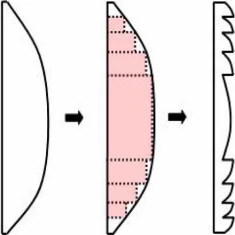Fresnel lens
2024-7-24
Fresnel lens, also known as the threaded lens, mostly by the polyolefin material injection pressure and into the sheet, there are also made of glass, the surface of the lens on one side of the surface for the optical surface, the other side of the recorded from small to large concentric circles, it is based on the texture of the interference and interference of light and the relative sensitivity and the angle of reception to the design of the requirements.


Basic Principle
The principle of operation is very simple: assuming that the refracted energy of a lens occurs only on the optical surface (e.g., the lens surface), as much of the optical material as possible is removed, while the curvature of the surface is preserved.
Another way of understanding this is that the continuous surface of the lens partially “collapses” into a plane. In profile, the surface consists of a series of jagged grooves with an elliptical arc in the center. Each notch is at a different angle to its neighboring notches, but they all concentrate light rays in one place, forming the central focus, which is the focal point of the lens. Each notch can be viewed as a separate small lens that adjusts the light into parallel or concentrated light. This type of lens also eliminates some of the spherical aberration.
Characteristics
With ordinary convex lenses, the corners will be darkened and blurred. This is because the refraction of light only occurs at the interface of the medium, and the convex lens is thicker, so the part of the light that travels in a straight line through the glass will cause the light to be attenuated. If the straight line part can be removed and only the surface where refraction occurs can be retained, a large amount of material can be saved and the same light gathering effect can be achieved at the same time. Fresnel lenses are based on this principle. A Fresnel lens looks like a piece of glass with numerous concentric lines (i.e. Fresnel bands), but it can achieve the effect of a convex lens, and if the projected light source is parallel light, it can keep the brightness of the image consistent everywhere after convergent projection.
The principle of operation is very simple: assuming that the refracted energy of a lens occurs only on the optical surface (e.g., the lens surface), as much of the optical material as possible is removed, while the curvature of the surface is preserved.
Another way of understanding this is that the continuous surface of the lens partially “collapses” into a plane. In profile, the surface consists of a series of jagged grooves with an elliptical arc in the center. Each notch is at a different angle to its neighboring notches, but they all concentrate light rays in one place, forming the central focus, which is the focal point of the lens. Each notch can be viewed as a separate small lens that adjusts the light into parallel or concentrated light. This type of lens also eliminates some of the spherical aberration.
Characteristics
With ordinary convex lenses, the corners will be darkened and blurred. This is because the refraction of light only occurs at the interface of the medium, and the convex lens is thicker, so the part of the light that travels in a straight line through the glass will cause the light to be attenuated. If the straight line part can be removed and only the surface where refraction occurs can be retained, a large amount of material can be saved and the same light gathering effect can be achieved at the same time. Fresnel lenses are based on this principle. A Fresnel lens looks like a piece of glass with numerous concentric lines (i.e. Fresnel bands), but it can achieve the effect of a convex lens, and if the projected light source is parallel light, it can keep the brightness of the image consistent everywhere after convergent projection.

